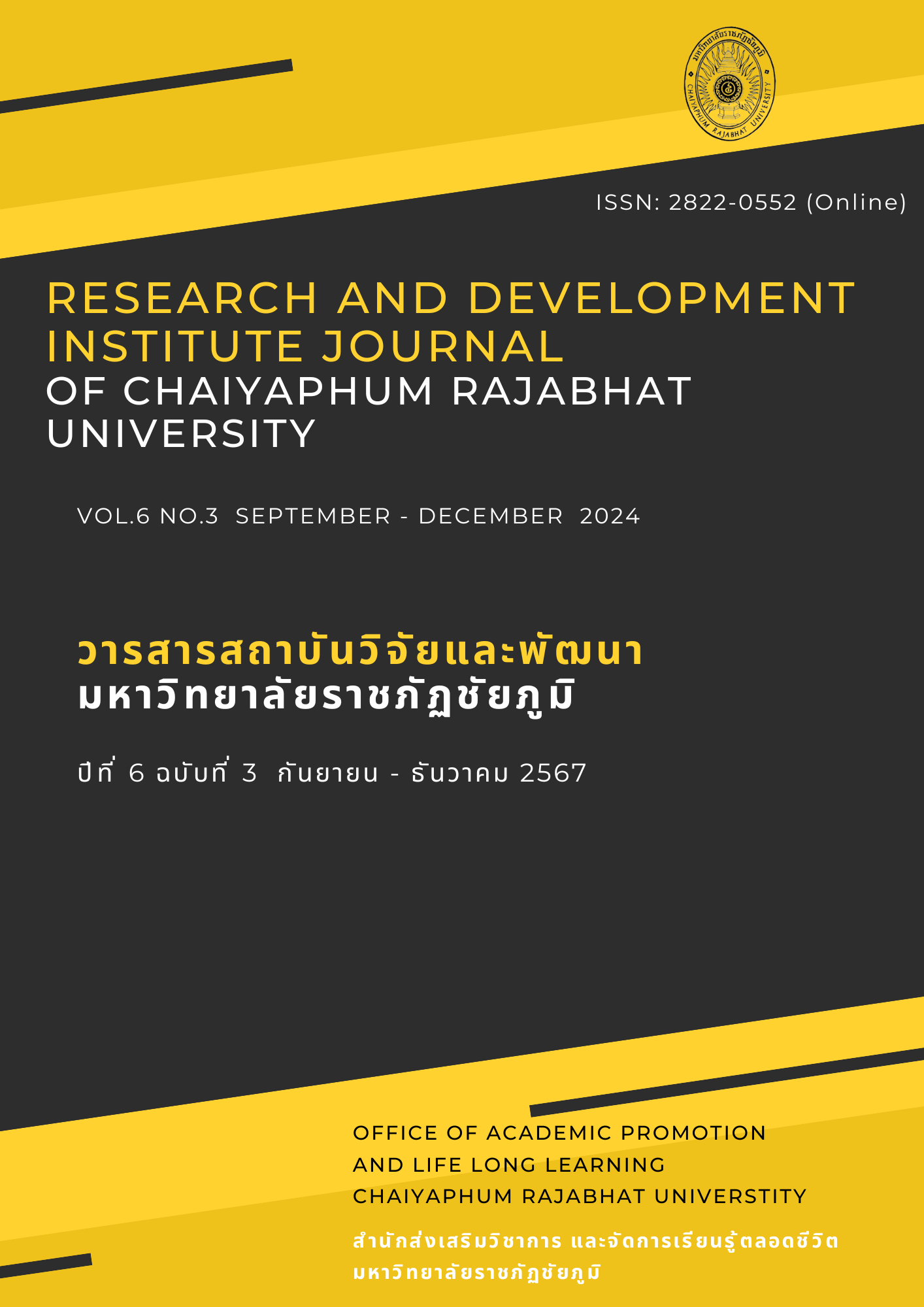THE EFFECTS OF JIGSAW II COOPERATIVE LEARNING TECHNIQUE ON THE ENVIRONMENTAL STUDIES UNIT OF GEOGRAPHY FOR GRADE 5
Main Article Content
Abstract
The objectives of this research were: 1) to compare the learning achievement in the environmental studies unit of grade 5 students before and after using the Jigsaw II cooperative learning technique, 2) to compare the learning achievement after applying the Jigsaw II cooperative learning technique with 80 percent criteria, and 3) to assess the group work behavior of grade 5 students. The sample group consisted of 26 5th-grade students from Ban Nong Pluang School, Mueang District, Nakhon Ratchasima Province, during the first semester of the 2024 academic year, selected through cluster random sampling. The research tools included lesson plans, an achievement test, and a group work behavior assessment form. Data analysis involved calculating means, percentages, and standard deviations.
The research findings were as follow: 1) The learning achievement in the environmental studies unit for grade 5 students after using the Jigsaw II cooperative learning technique was statistically significance higher than before using it at the 0.05 level. 2) The learning achievement in the environmental studies unit for grade 5 students after using the Jigsaw II cooperative learning technique was 86.28%, significantly surpassing the 80% criterion at the 0.05 level, and 3) The group work behavior of grade 5 students after learning with the Jigsaw II technique had an average score of 4.13, which is at a good level.
Article Details

This work is licensed under a Creative Commons Attribution-NonCommercial-NoDerivatives 4.0 International License.
Permission to use text, content, images, etc. of publication. Any user to read, download, copy, distribute, print, search, or link to the full texts of articles, crawl them for indexing, pass them as data to software, or use them for any other lawful purpose. But do not use it for commercial use or with the intent to benefit any business. Published under a Creative Commons Attribution-NonCommercial-NoDerivatives 4.0 International License.

This work is licensed under a Creative Commons Attribution-NonCommercial-NoDerivatives 4.0 International License
References
กนก จันทรา (2562). การจัดการเรียนรู้เพื่อการรู้เรื่องภูมิศาสตร์ในวิชาสังคมศึกษา. http://academic.obec.go.th/images/mission/1524627007_d_1.pdf
ทิพวรรณ์ สลีอ่อน, ระพีพัฒน์ เดือนเพ็ญ และสิราวรรณ จรัสรวีวัฒน์. (2564). ผลการจัดกิจกรรมการเรียนรู้แบบร่วมมือด้วยเทคนิคจิ๊กซอว์ 2 วิชาสังคมศึกษา ศาสนา และวัฒนธรรม ของนักเรียนชั้นประถมศึกษาปีที่ 6. วารสาร มหาวิทยาลัยบูรพา (HRD Journal), 12(1), 42-55.
ทิศนา แขมมณี. (2553). ศาสตร์การสอน องค์ความรู้เพื่อการจัดกระบวนการเรียนรู้ที่มีประสิทธิภาพ. จุฬาลงกรณมหาวิทยาลัย.
ทิศนา แขมมณี. (2560). รูปแบบการเรียนการสอน ทางเลือกที่หลากหลาย (พิมพ์ครั้งที่ 9). จุฬาลงกรณมหาวิทยาลัย.
บุญชม ศรีสะอาด. (2560). การวิจัยเบื้องต้น (พิมพ์ครั้งที่ 6). สุวีริยาสาส์น.
ปิยะนันท์ บุญโพธิ์, และเพชรรัตน์ จงนิมิตสถาพร. (2562). การศึกษาผลสัมฤทธิ์ทางการเรียนและทักษะการทำงานกลุ่ม โดยใช้การสอนแบบร่วมมือกันเรียนรู้ด้วยเทคนิค JIGSAW กลุ่มสาระการเรียนรู้สังคมศึกษา ศาสนา และวัฒนธรรม ของนักเรียนชั้นประถมศึกษาปีที่ 4 โรงเรียนสาธิตมหาวิทยาลัยขอนแก่น ฝ่ายประถมศึกษา (ศึกษาศาสตร์). วารสารศึกษาศาสตร์ มหาวิทยาลัยขอนแก่น (EDKKUJ), 42(2), 65-71
วัชรา เล่าเรียนดี. (2548). เทคนิคการจัดการเรียนการสอนและการนิเทศ. มหาวิทยาลัยศิลปากร วิทยาเขตพระราชวังสนามจันทร์.
วิมลรัตน์ สุนทรโรจน์.(2545). พัฒนาการเรียนการสอน. มหาวิทยาลัยมหาสารคาม.
Rhoades, J. & McCabe, E M. (1993). The cooperative classroom. National Education Service: Bloomington
Slavin, R. E. (1995). Cooperative Learning: Theory, Research and Practice. Allyn and Bacon


